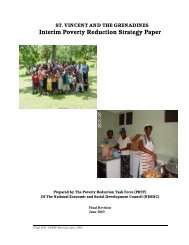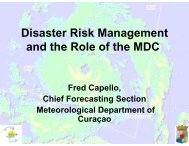The Anatomy of A Silent Crisis The Anatomy of A Silent Crisis
The Anatomy of A Silent Crisis The Anatomy of A Silent Crisis
The Anatomy of A Silent Crisis The Anatomy of A Silent Crisis
- TAGS
- anatomy
- www.bb.undp.org
Create successful ePaper yourself
Turn your PDF publications into a flip-book with our unique Google optimized e-Paper software.
Notes on report methodology<br />
Resulting projections <strong>of</strong> “seriously affected” and “deaths“ used in Human Impact Report<br />
Year Global<br />
attribution<br />
2010 40 percent<br />
<strong>of</strong> weatherrelated<br />
disasters<br />
2030 50 percent<br />
<strong>of</strong> weatherrelated<br />
disasters<br />
Validation and context<br />
Number <strong>of</strong><br />
people affected<br />
87 million<br />
(40 percent <strong>of</strong><br />
219 million people<br />
affected on<br />
average between<br />
2000 and 2008<br />
by droughts,<br />
temperature<br />
extremes, floods,<br />
storms, wildfires)<br />
351 million<br />
(50 percent <strong>of</strong><br />
702 million people<br />
affected if we<br />
assume a 320<br />
percent increase<br />
from today as in<br />
the latest Feinstein<br />
Center Report)<br />
Number <strong>of</strong><br />
deaths<br />
14,500<br />
(40 percent <strong>of</strong><br />
36,000 deaths<br />
on average<br />
between 2000<br />
and 2008 due<br />
to droughts,<br />
temperature<br />
extremes,<br />
floods, storms,<br />
wildfire)<br />
29,000<br />
(50 percent <strong>of</strong><br />
58,000)<br />
Sources Assumptions<br />
• Munich Re<br />
• Baines and<br />
others for<br />
comparison<br />
• Munich Re<br />
• Baines for<br />
comparison<br />
• Feinstein<br />
Center<br />
No climate change before 1980<br />
All non-climate change related<br />
factors are equally reflected in<br />
the geophysical trend<br />
<strong>The</strong> climate change attribution<br />
to the number <strong>of</strong> events can<br />
be used as a proxy for the<br />
attribution <strong>of</strong> climate change in<br />
terms <strong>of</strong> number <strong>of</strong> affected/<br />
deaths/ economic losses<br />
See above<br />
Deaths increase only half as<br />
fast as the number <strong>of</strong> people<br />
affected<br />
<strong>The</strong> attribution estimates compare well to the sectoral and regional estimates that have been<br />
published. For instance, Baines 2009 estimates that 37 percent <strong>of</strong> drought is due to climate<br />
change, 251 and Dorland et al., 252 Leckebusch et al., 2007, 253 Hanson et al., 2004 254 come up with<br />
similar proportions for regional studies.<br />
<strong>The</strong> assumption that the frequency <strong>of</strong> events translates into a proportional number <strong>of</strong> people<br />
affected and number <strong>of</strong> deaths may be viewed as conservative:<br />
• <strong>The</strong> overall proportion <strong>of</strong> people affected by weather-related disasters is significantly greater than<br />
for earthquakes. <strong>The</strong> intensity <strong>of</strong> floods and storms may also increase due to climate change.<br />
• A number <strong>of</strong> factors may worsen consequences <strong>of</strong> natural disasters independent <strong>of</strong> climate change.<br />
Some <strong>of</strong> these factors should affect the outcome <strong>of</strong> weather disasters but not geophysical disasters.<br />
Examples include: more people living in coastal regions exposed to hurricanes and cyclones; and<br />
more people live in conditions <strong>of</strong> poverty and among dense populations in communities with low<br />
resilience to the effects <strong>of</strong> disasters.<br />
87







